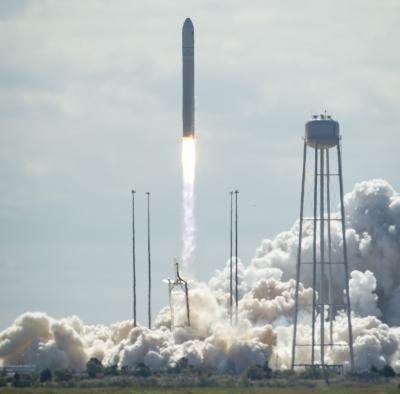Thu, Sep 19, 2013
Cygnus Cargo Spacecraft On Its Way To ISS
NASA commercial space partner Orbital Sciences Corporation of Dulles, VA, successfully launched its Cygnus cargo spacecraft aboard its Antares rocket at 1058 EDT Wednesday from the Mid-Atlantic Regional Spaceport Pad-0A at NASA’s Wallops Flight Facility in Virginia. This is the first time a spacecraft launched from Virginia is blazing a trail toward the International Space Station, heralding a new U.S. capability to resupply the orbiting laboratory.

Traveling 17,500 mph in Earth's orbit, Cygnus is on its way to rendezvous with the space station Sunday, Sept. 22. The spacecraft will deliver about 1,300 pounds of cargo, including food and clothing, to the Expedition 37 crew, who will grapple and attach the capsule using the station's robotic arm.
"Today marks a milestone in our new era of exploration as we expand the capability for making cargo launches to the International Space Station from American shores," said NASA Administrator Charles Bolden. "Orbital's extraordinary efforts are helping us fulfill the promise of American innovation to maintain our nation's leadership in space."
Orbital is building and testing its Antares rocket and Cygnus spacecraft under NASA’s Commercial Orbital Transportation Services (COTS) Program. The successful completion of the COTS demonstration mission will pave the way for Orbital to conduct eight planned cargo resupply flights to the space station through NASA’s $1.9 billion Commercial Resupply Services contract with the company. Future Cygnus flights will significantly increase NASA's ability to deliver new science investigations to the only laboratory in microgravity. As one of two U.S. carriers capable of providing cargo resupply missions to the space station, a successful demonstration mission will ensure a robust national capability to deliver critical science payloads to orbit. NASA's other cargo resupply provider, Space Exploration Technologies (SpaceX), began flying regular cargo missions to the space station in 2012, following its own COTS demonstration mission.
"Today’s launch is the culmination of more than five years’ work between the NASA and Orbital teams," said Alan Lindenmoyer, NASA’s program manager for commercial crew and cargo. "Everyone involved should be extremely proud, and we are looking forward to a successful series of checkouts between now and when Cygnus reaches the space station this weekend."
Over the next several days, Cygnus will perform a series of maneuvers to test and prove its systems, ensuring it can safely enter the so-called "keep-out sphere" of the space station, a 656-foot radius surrounding the complex.
(Image provided by NASA)
More News
Newest USAF Drone Begins Process in Earnest The YFQ-42A Collaborative Combat Aircraft has begun its flight testing in coordination with the U.S. Air Force, taking a vital step towa>[...]
“What a great moment for the U.S. Air Force and for GA-ASI. It’s been our collaboration that enabled us to build and fly the YFQ-42A in just over a year. It’s an >[...]
Airline Pilots Jettisoned 15,000 Pounds of Fuel Over Populated Areas Five years after one of its Boeing 777s dumped 15,000 pounds of jet fuel onto neighborhoods, Delta Air Lines ha>[...]
GAO Report Says that Only 69 Aviation Meteorologists Work Alongside ATC A federal watchdog says the FAA is running the nation’s air traffic system with fewer weather experts >[...]
Also: 500-Aircraft Deal With China, Florida ANG's F-35, FAA Denies Petition, UC Central Arkansas Aviation Academy The Reno Air Racing Association (RARA) is offering its apologies t>[...]
 YFQ-42A Collaborative Combat Aircraft Starts Flight Testing
YFQ-42A Collaborative Combat Aircraft Starts Flight Testing Aero-News: Quote of the Day (09.02.25)
Aero-News: Quote of the Day (09.02.25) Delta Settles Fuel Dump Lawsuit in a $78M Handshake
Delta Settles Fuel Dump Lawsuit in a $78M Handshake Watchdog Warns of Another Understaffed FAA Program: Meteorology
Watchdog Warns of Another Understaffed FAA Program: Meteorology Airborne 08.27.25: Air Race Tkt Discounts, Europe AvGas, Deportation Flights?
Airborne 08.27.25: Air Race Tkt Discounts, Europe AvGas, Deportation Flights?



